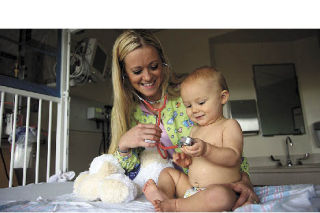Cold and flu season is here and some of our most vulnerable are at risk of contracting respiratory syncytial virus, or RSV, a major cause of respiratory illness in young children. Dr. Fadi Aljabi, with MultiCare’s Mary Bridge Pediatric Care at Good Samaritan, helps parents understand this infection and how they can help their little one feel better.
What is RSV?
RSV causes infection of the lungs and breathing passages. In adults, it may only produce symptoms of a common cold like a stuffy or runny nose, sore throat, mild headache, cough, fever and a general ill feeling. But RSV infections can lead to other more serious illnesses in premature babies and kids with diseases that affect the lungs, heart or immune system, and sometimes in previously healthy children.
What are the
symptoms of RSV?
RSV usually causes the same symptoms as a bad cold, like a cough, stuffy or runny nose, earache or fever.
Babies with RSV may have no energy, act fussy or cranky or be less hungry than usual.
Some children have more serious symptoms, like wheezing. Call your doctor if your child is wheezing or having trouble breathing.
How is RSV spread?
RSV is highly contagious and can be spread through droplets containing the virus when a person coughs or sneezes. The virus can also live on surfaces such as countertops or doorknobs and on hands and clothing. RSV can be easily spread when a person touches an object or surface contaminated with the virus. The infection can spread rapidly through schools and child-care centers. Infants often get RSV when older kids carry the virus home from school. Almost all kids are infected with RSV at least once by the time they are 2 years old.
How do you test for RSV?
Doctors typically diagnose RSV by taking a medical history and doing a physical exam. Generally, in healthy kids, it’s not necessary to distinguish RSV from a common cold. But in cases where a child has other health conditions, a doctor might want to make a specific diagnosis. RSV is typically identified in nasal secretions, which can be collected either with a cotton swab or by suction through a bulb syringe.
Who is considered
high-risk for RSV?
Babies born prematurely at 35 weeks or earlier, babies born with heart disease and babies with chronic lung disease.
Treating RSV
Fortunately, most cases of RSV are mild and require no specific treatment from doctors. Antibiotics aren’t prescribed because RSV is a virus and antibiotics are only effective against bacteria. Medication may sometimes be given to help open airways.
At home, make a child with an RSV infection as comfortable as possible, allow time for recovery and provide plenty of fluids. The last part can be tricky, because babies may not feel like drinking. In that case, offer fluids in small amounts at more frequent intervals than usual.
To help a child breathe easier, use a cool-mist vaporizer during the winter months to keep the air moist – winter air can dry out airways and make the mucus stickier. Avoid hot water and steam humidifiers, which can be hazardous and can cause scalding. If you use a cool-mist humidifier, clean it daily with household bleach to discourage mold.
If your child is uncomfortable and too young to blow his or her own nose, use a nasal aspirator (or bulb syringe) to remove sticky nasal fluids.
Treat fever using a nonaspirin fever medicine like acetaminophen. Aspirin should not be used in children unless specifically prescribed by a medical provider.
In an infant, an RSV infection can be more serious and may require hospitalization so that the baby can be watched closely, receive fluids and, if necessary, be treated for breathing problems.
When to Call the Doctor
Call the doctor immediately if your child has any of these symptoms: high fever with ill appearance; thick nasal discharge that is yellow, green or gray; worsening cough or cough that produces yellow, green, or gray mucus; difficulty feeding or fewer wet diapers than usual; or having a purplish or slight gray color in the face, hands and feet.
Call also if you think your child might be dehydrated or having difficulty breathing.
In infants, besides the symptoms already mentioned, call the doctor if your baby is unusually irritable or inactive, or refuses to breastfeed or bottle-feed.
Call 911 if the child is: Making a grunting noise; having a purplish or slight gray color in the face, hands and feet; unable to speak, cry or make sounds; severe sucking in of the skin around the ribs or the base of the neck when breathing; or not breathing for more than 15 seconds.
How to prevent RSV
Frequent hand washing can go a long way toward preventing the virus from spreading around a household. It’s best to wash your hands after having any contact with someone who has any cold symptoms. And keep your school-age child with a cold away from younger siblings, particularly infants, until the symptoms pass.
To prevent serious RSV-related respiratory disease, at-risk kids can be given a monthly injection of a medication consisting of RSV antibodies during peak RSV season (roughly November to April). Because its protection is short-lived, it has to be given in subsequent years until the child is no longer at high risk for severe RSV infection. Ask the doctor if your child is considered high risk.
Fadi Aljabi is a hospitalist with Mary Bridge Pediatric Care at Good Samaritan Hospital. He is a graduate of the University of Damascus School of Medicine and the Wayne State University Pediatric Residency at the Children’s Hospital of Michigan.


